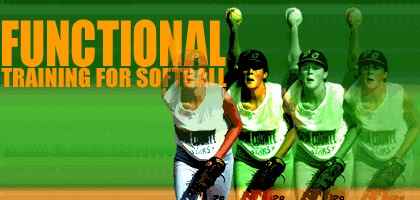Most fitness and training facilities now have stability balls, foam rolls, balance boards and other “fun” toys as part of their conditioning equipment. These are part of a new trend in the strength and conditioning field called “functional training”.

Definition
Functional training is the action of training “function”, a general term that means “role or duty”. Functional training is the science of training the body to meet the specific demands of life and sports.
It is based on:
- The principle of specificity
- Muscle function
The principle of specificity also known as SAID (Specific Adaptations to Imposed Demands) means that the body responds and adapts specifically to the type and amount of physical demands under which it is placed. In other words, you only improve what you’ve specifically trained. Since muscle form dictates the role and function of each muscle, muscle needs to be trained the way it is designed to function.
Origin
Functional training is nothing new and comes primarily from the rehabilitation field. For decades, therapists have experimented with ways to help their patients regain function. Their goal is to retrain muscles to work properly using special exercises. In their quest to help their patients to become more functional, they have a developed functional training approach.
Traditional vs. Functional
Traditional strength training usually consists of trying to develop strength and build muscle through isolating specific muscle groups. This type of training could be called dysfunctional training and only develop segmental strength. Traditional strength training is adequate for building muscle but it does not train the body to meet the specific demands of life and sports. It does not reproduce real life conditions and only serves to create non-functional strength.
Peter Twist, Vancouver Canucks Strength and Conditioning Coach, explains: “Typical strength training attempts to develop the body through a piecemeal approach, isolating specific muscle groups. Worse yet, this is often done with the body unloaded, sitting stationary on a machine while moving one isolated body part through a controlled range of motion, usually in a strict linear, straight ahead motion”.
Traditional strength training trains isolated muscle function while functional training trains the body to work as a unit. The central nervous system is programmed to make the body function as a unit, not to work in terms of isolated muscle function. Functional training is “functional” since it trains the body the way it has been designed to function.
Benefits Of Functional Training
This type of training has many benefits but the most important one being that it creates a healthy, well-conditioned body. Some of the major benefits are:
To develop kinesthetic awareness and body control
To improve posture
To improve muscle balance
To decrease incidence of injury
To improve athletic performance
To have a positive effect on spinal health
To enhance movement efficiency
To give a more narrow-waist look (as a result of an improved posture)
To improve both dynamic and static balance
Functional training offers more benefits overall than traditional strength training. A combination of both is still possible if you are looking for the benefits of functional training while looking to specifically develop muscles. As a rule of thumb, always perform functional training first when your nervous system is still fresh.

Functional Exercises
“Highly functional exercises need to facilitate as much multi-joint involvement as possible to create muscular and joint interdependency; it also need to challenge the body with proprioceptively-enriched exercises in an unstable environment that excite and develop the nervous system” says Mark Cibrario, Owner of a personal training studio and expert in functional training.
In each movement, various muscles are involved and they all play a different role. The central nervous system, responsible for muscle activation, is programmed for integrated kinetic chain movement which involves the agonist (prime mover), antagonist (opposite to prime mover), synergists (assist prime mover), stabilizers (which stabilize joints while prime movers and synergists perform movement) and neutralizers (which counteract unwanted action of others muscles). All these together work to reproduce an efficient movements. The body is not designed for isolated muscle function. Each movement requires an integration of various muscles.
It has been shown that the body responds better to training in an unstable environment which challenge the nervous system. This is the reason why functional training uses so many tools to create instability. To train function, an exercise must engage the superficial core muscles to help produce force, reduce force, or dynamically stabilize the spine, along with the deep inner unit musculature to provide segmental stability and stiffness to the spine.
To be functional, an upper body exercise must also activate shoulder joint stabilizers and neutralizers and a lower body exercise must activate the hip, knee and ankle joint stabilizers. These exercises also need to balance body segments over one’s base of support and challenge the body to maintain ideal posture.
The body is designed to work as a unit with muscles firing up in a specific sequence to produce the desired movement.
Popular Strength Coach from International Performance Institute, Mark Verstegen says “Your world is 360 degrees; it’s chaos”. In other words, your body needs to train at every angle and in every plane to mimic real life.
Functional training is also based on the principle of individualization. What is functional for one, is not necessarily functional for another. Each individual has different functional needs and these needs have to be assessed before a functional training program can be recommended. Functional exercises will vary, based on a person’s needs and the specific demands they have to meet in their daily life and in sports.
Conclusion
Functional Training has many benefits and should be part of any exercise program whether it is for sport-specific conditioning, rehabilitation or general fitness. Traditional strength training should serve as a complement to functional training.
Not only is functional training an excellent concept but it is also fun and challenging. A word of advice: get familiar with stability balls, balance boards and foam rolls and add a whole new dimension to your workout.